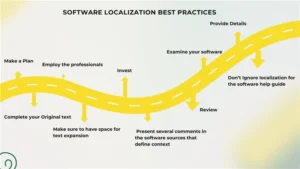Software Localization Best Practices
 Many organizations are looking forward to expanding their business and offer software applications for the global marketplace via localization.
Many organizations are looking forward to expanding their business and offer software applications for the global marketplace via localization.
Software localization is the process of translating the text within a software product into various languages so it can be used by customers in a particular region or location.
But sometimes many localization efforts are wasted due to technical problems like incorrect fonts, language coding errors, or phrases being cut off.
Here are some suggestions to assist you in preventing these difficulties and create an excellent product for the international market.
1. Make a Plan
Software localization should not be a last-minute decision before the software release. To produce a high-quality product, you must pick the right professional translators that suit your application requirements.
2. Employ the Professionals
Don’t hire students or amateur translators, especially on complex projects like software localization. Make sure to hire only professional translators because they will provide you with high-quality translations that meet your needs.
3. Invest
Excellent quality has its cost, so you must be prepared to invest in high-quality translation. Otherwise, your own prospects will discover poor quality and it may result in bad reviews, which are not a good thing for your business.
4. Examine Your Software
Make sure to test the localized software as strictly as the primary English version before launching to the target market. This prevents functional problems like missing text, mistranslations, or localization bugs.
5. Provide Details
Provide the translation agency with details about your application such as the target audience or clients. Make sure to supply them with all necessary instructions.
6. Complete Your Original Text
It is highly recommended to complete the original text prior to translation. Otherwise, it will be more complicated to estimate costs and manage updates.
7. Make Sure to Have Space for Text Expansion
Many languages require about 30% more space than English. If your software is designed to fit only English text, you’ll face problems. Leave extra space or use a dynamic UI extension.
8. Provide Comments in the Source Code
Adding comments that explain the context of specific strings will help translators choose the correct translation from the start.
9. Review
If you hire multiple translators, you may need to review the quality of translations for consistency. For large projects, appoint a translation reviewer. Alternatively, work with a reputable professional agency that handles quality assurance.
10. Don’t Ignore Localization for the Help Guide
Users will notice inconsistencies if help documentation refers to buttons labeled differently in the application. To guarantee reliability, seek an experienced translation company that can manage both the software UI and user guides simultaneously.
Software localization can be challenging, but by following these best practices, you can avoid major pitfalls and deliver a product that feels natural and user-friendly across global markets.









